Physical Address
304 North Cardinal St.
Dorchester Center, MA 02124
The shoulder is unique in that it is the most mobile joint in the human body. It serves primarily to position the hand in space and thus requires a delicate balance of stability and flexibility to accomplish its function. The inherent complexity of the glenohumeral joint requires contributions from both dynamic and static stabilizers to achieve this balance. Further, whereas some activities, such as swimming, place a premium on flexibility, others, such as lifting a weight overhead, value stability more highly. Shoulder instability is a spectrum of pathologic conditions in which the humeral head exceeds the functional or physiologic limit of the confines of the glenoid labral complex, resulting in a sensation that is troubling to the patient.
Instability of the shoulder can be in any cardinal direction or in a combination of directions. In 1980 Neer and Foster introduced the term multidirectional instability (MDI) , which refers to anterior and posterior instability associated with involuntary inferior subluxation or dislocation. Matsen subsequently categorized shoulder instability into two general types: (1) traumatic and unidirectional with a Bankart lesion treated surgically, and (2) atraumatic, multidirectional , and bilateral, responds to rehabilitation, and may require an inferior capsular shift for surgical treatment. Although these categories are helpful for general classification, one must be careful not to oversimplify MDI. Patients with MDI can certainly present with unilateral symptoms, and although it is less common, they may present only after a traumatic event. As a result, both Neer's description of MDI and Matsen's description of the second general type have been modified to reflect our increasing understanding of the multidirectionally unstable shoulder.
It is important to consider the contributions of both normal anatomy and functional demands to more fully understand MDI. Laxity is highly variable within the shoulder and thus, in and of itself, is not equal to instability. Many patients use an increase in laxity to optimize performance; for example, laxity provides elite swimmers with a competitive advantage. These athletes rely on a dynamic stability provided by the shoulder and periscapular musculature to allow extreme ranges of motion without pathologic instability. Thus physical signs of laxity, such as the sulcus sign, or the ability of a patient to demonstrate subluxation, should not be equated with shoulder instability. Without a precise definition of MDI, it is critically important to use all the tools available to the treating physician, including history, physical examination, imaging, examination while the patient is anesthetized, and diagnostic arthroscopy, to ensure that the appropriate anatomic deficiency of patients with MDI is addressed.
Glenohumeral stability results from a complex interplay of static and dynamic stabilizers. Static stabilization of the glenohumeral joint is controlled by such factors as the native depth of the glenoid and surrounding labral complex, as well as the length and stiffness of the shoulder capsule and supporting ligaments. Although the depth of the glenoid has been shown to provide a small restraint to glenohumeral translation, and patients with MDI demonstrate glenoid cavities that are more shallow than those of age-matched control subjects, the characteristic pathologic entity in persons with MDI is increased capsular redundancy. This redundancy may be congenital and associated with a systemic disease, such as Ehlers-Danlos syndrome, osteogenesis imperfecta, Marfan syndrome, benign joint hypermobility syndrome, and fascioscapulohumeral dystrophy, or it can be acquired from repeated minor injuries (microtrauma) or repetitive use during exercises that stretch the capsuloligamentous restraints. Different parts of the capsule have been shown to be responsible for glenohumeral stability because the position of the shoulder and the direction of opposing forces are varied. The anterior and posterior bands of the inferior glenohumeral ligament act as a hammock to balance the humeral head on the glenoid. The most significant restraint to inferior subluxation of the humeral head is the rotator interval complex, consisting of the superior glenohumeral ligament and coracohumeral ligament together with the inferior glenohumeral ligament complex.
The shoulder is also dynamically stabilized by the rotator cuff, deltoid, and long head of the biceps, which collectively serve to compress the humeral head into the glenoid in a phenomenon coined concavity compression. One study demonstrated that the shoulder could resist translational loads equal to 60% of the compressive load applied. In addition, the periscapular musculature can affect the position of the scapula, effectively altering glenoid version and inclination. Although the role of these dynamic stabilizers is more difficult to study, abnormal scapular kinematics and muscle activation patterns have been demonstrated in patients with MDI compared with asymptomatic control subjects. One explanation of the etiology of MDI is the combination of baseline hyperlaxity and acquired scapular muscle dysfunction. This theory may explain why some swimmers present with impingement syndrome, why some baseball pitchers experience internal impingement, and why other patients with hyperlaxity present with pain as their chief complaint.
MDI can be very challenging to diagnose correctly. Patients usually do not report instability but rather vague pain of insidious onset, and thus the chief complaint is often not suggestive of the diagnosis. Further, although patients usually present with hyperlaxity, it is often not significantly different from their asymptomatic other side, and thus discerning between normal laxity versus instability in a particular patient can be confusing. Nevertheless, the history and physical examination are the critical steps in making an accurate diagnosis, and maintaining a high level of clinical suspicion is essential given the variety of presenting complaints.
Most patients with MDI present with a chief complaint of activity-related pain, but they may also report decreased strength or athletic performance. It is important to identify which activities are causative, because MDI is more common in overhead throwing sports, and the offending activity gives insight into both the focus of treatment and the patient's expectations for return. Reports of pain when carrying a heavy object, such as a suitcase, should raise suspicion. Cofield and Irving stressed four questions in the workup of MDI: (1) What is the relationship to trauma? (2) Does the patient intentionally cause the instability? (3) What is the degree of instability? (4) What is the direction of instability? Regarding the first question, most patients with MDI have an atraumatic onset, whereas a single inciting event can be responsible for tipping the patient from hyperlaxity to instability. If one loosens the definition of “trauma” to include repetitive use or conditions that compromise the dynamic stabilizers, one can gain a much deeper understanding of the source of the patient's complaints and a rational approach to addressing them. The second question about volitional instability by Cofield and Irving is also critical. Since publication of the classic article by Rowe and colleagues, it has become a tenet that patients with willful dislocation should be approached cautiously. However, as pointed out by Mallon and Speer, it should be remembered that not all patients who have the ability to dislocate the shoulder have a psychologically pathologic condition, which is an important differentiator in the treatment algorithm.
The degree of instability is another important component of the history. Patients with MDI may undergo either recurrent subluxation or dislocation, although the former is more common, and an understanding of the degree of instability may help determine the aggressiveness of the treatment program. When patients report that their joint “slips” out in the absence of trauma or during sleep, clinical suspicion should be heightened. Finally, the question of the primary direction of instability in patients with MDI is critical to making a complete and accurate assessment and correctly designing an approach to treatment. Most patients do not have true global instability, and distinguishing between true MDI and unidirectional instability with multidirectional laxity is one of the critical steps guiding treatment. Finally, it is critical to understand the diagnosis in the context of the patient. The type of activity the patient expects to resume and within what time frame, as well as the management of the individual patient's expectations about rehabilitation and return, are essential in guiding successful treatment.
Foster has noted that the most useful tool for making the diagnosis of MDI is the physical examination. Because patients with MDI often have vague complaints, it is essential to perform a thorough physical examination. Generalized ligamentous laxity has long been considered a hallmark of MDI and should be evaluated in each patient. Beighton et al. reported on five physical signs of joint hyperlaxity ( Table 42.1 ), which add up to a potential of nine points. Knee, elbow, thumb, and metacarpophalangeal hyperextension are all given a point for each side, along with the patient's ability to place his or her hands flat on the floor with straight knees from a standing position. Any score greater than 3 is considered good evidence of generalized ligamentous laxity and should alert the examiner to the presence of this condition. Other classification systems have been reported for collagen disorders, including the Villefranche nosology system for Ehlers-Danlos syndrome subtypes and the Ghent criteria defining Marfan syndrome. It is important to recognize these connective tissue disorders, because they have been associated with poorer results after surgical stabilization. Finally, hyperelasticity and scarring in skin folds, as well as keloid formation or widening of scars, are also suggestive of a collagen disorder. The presence of generalized ligamentous laxity is not sufficient for the diagnosis of instability because a wide spectrum of asymptomatic laxities exists in all cardinal directions.
| Characteristic | Score |
|---|---|
| Passive dorsiflexion of the little finger beyond 90 degrees | 1 point for each hand |
| Passive apposition of the thumb to the ipsilateral forearm | 1 point for each hand |
| Active hyperextension of the elbow beyond 10 degrees | 1 point for each hand |
| Active hyperextension of the knee beyond 10 degrees | 1 point for each hand |
| Forward flexion of the trunk with extended knees so that the palms of the hands rest flat on the floor | 1 point |
Since the original description by Neer and Foster, the sulcus sign has been considered the sine qua non of MDI ( Fig. 42.1 ). This test is performed by placing axial traction on the arm in its resting position at the patient's side and can be evaluated with rotation, as well as at varying degrees of abduction. This action should produce a visible and palpable sulcus underneath the acromion as the humerus translates inferiorly. Although Harryman et al. noted significant variation in what a “normal” sulcus is, in a healthy control group, the sulcus measured approximately 11 mm upon testing. Humeral head displacement of more than 2 cm from the acromion, as well as the presence of a sulcus sign with 90 degrees abduction, is indicative of considerable inferior capsular laxity. It is again important to heed Matsen's caution that to make the diagnosis of MDI, the sulcus sign must reproduce the patient's symptoms.
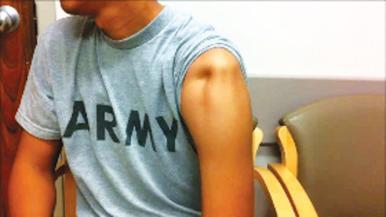
The hyperabduction test as described by Gagey and Gagey is another test for inferior glenohumeral laxity in which patients are evaluated for comparative glenohumeral abduction. In asymptomatic volunteers, abduction averages greater than 90 degrees, and a positive test is indicated by passive abduction greater than 105 degrees. Although MDI was an exclusion criterion in the study, Balg and Boileau found shoulder hyperlaxity anteriorly or inferiorly, as defined by excessive external rotation and a positive hyperabduction test, respectively, to be an independent variable for recurrent instability after an arthroscopic Bankart procedure.
In addition to inferior instability, it is important to examine any patient with suspected MDI for anterior and posterior instability. With the common finding of generalized laxity, it is important that these provocative maneuvers result in the reproduction of the patient's symptoms. The apprehension test is a workhorse test for anterior instability that is performed with the patient either seated or supine. With this test, the examiner takes the patient's arm into maximal external rotation with the shoulder at 90 degrees of abduction. Reproduction of the patient's symptoms here is a reliable indicator of anterior instability. Another common method of assessment for instability is the abducted anterior load-and-shift test. This test is performed with the patient either in the seated, supine, or lateral decubitus position ( Fig. 42.2 ). This latter position is particularly helpful because the scapula can be controlled with one hand while the humerus is translated with the other. The humeral head is loaded axially to ensure it is centered and then translated forward. The test is graded on the basis of how far the humeral head travels in relation to the glenoid ( Table 42.2 ) : Grade 0, little to no movement of the humeral head; grade 1, the humeral head rides up to the glenoid labrum; grade 2, the humeral head is shifted off the glenoid but spontaneously reduces when pressure is removed; and grade 3, the humeral head is shifted off the glenoid and remains dislocated once the pressure is removed.
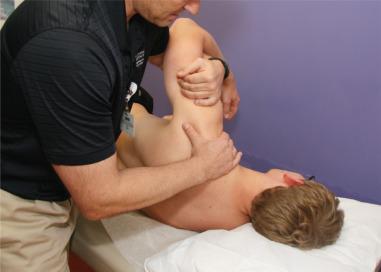
| Grade | Characteristic Glenoid Position |
|---|---|
| 1 | Little to no movement of the humeral head |
| 2 | The humeral head rides up to the glenoid labrum |
| 3 | The humeral head is shifted off the glenoid but spontaneously reduces when pressure is removed |
| 4 | The humeral head is shifted off the glenoid and remains dislocated once the pressure is removed |
For posterior instability, a similar load and shift maneuver can be performed. We have found that a modification of this test, the push-pull test, is most effective in controlling posterior translation ( Fig. 42.3 ). The push-pull test is performed with the patient supine; the arm is placed at 90 degrees abduction in neutral rotation and 30 degrees horizontal adduction. The examiner grasps around the patient's wrist with one hand (the pull) and posteriorly loads the humerus (the push), which places a fulcrum on the shoulder and enhances the examiner's ability to control subluxation. The evaluation of instability in all three directions is essential to determine the most effective treatment regimen for the patient.
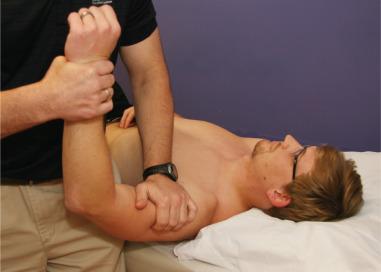
It must be remembered that MDI is a combination of static and dynamic restraints, and therefore the physical examination of any patient with suspected MDI must include a thorough evaluation of the patient's musculature. This evaluation begins with visualization of the patient's scapular musculature and kinematics. Patients should be evaluated for atrophy, winging, and scapular motion. Deltoid and rotator cuff strength should be assessed and compared with the opposite side, with particular attention directed to scapular rhythm as the arm moves, specifically through the motion that causes the patient's symptoms. Symptoms can be far better explained by asymmetries in the musculature than by shoulder laxity.
Although MDI is primarily diagnosed clinically, imaging can enhance the work-up in many patients. Radiographs should be evaluated for abnormal glenoid version, dysplasia, or hypoplasia, and humeral head abnormalities also occasionally can be detected on radiographs. Magnetic resonance imaging provides a clearer picture of the soft tissue anatomy in the shoulder and is often combined with magnetic resonance arthrography to give perhaps the gold standard of anatomic evaluation for MDI. Although labral pathology can certainly be present in patients with MDI, the classic finding is increased capsular volume and a patulous capsule ( Fig. 42.4 ). Schaeffeler et al. correlated the clinical diagnosis of atraumatic MDI with redundancy signs on magnetic resonance arthrography with high sensitivity and specificity. The finding of an increase in the rotator interval dimension of patients with MDI has been mixed. A large retrospective review by Lee et al. demonstrated larger rotator interval and capsular dimensions in MDI shoulders compared to controls. More recent research by Lim et al. looked at labrocapsular distances on magnetic resonance arthrography and found the inferior labrocapsular distance to have a high specificity and sensitivity of detecting clinical MDI.
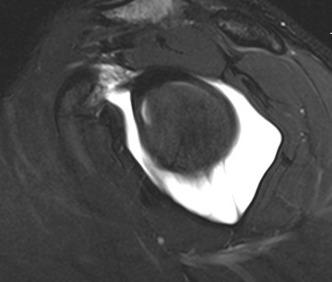
The most important principle of treatment in patients with MDI or any shoulder pathology is an understanding of the activities performed by the patient. Especially in the athlete, a fine line often exists between the advantage of laxity and the limitations of instability. As noted earlier in the history section, understanding how the patient uses the shoulder and the expectations of the patient are essential to guide proper treatment.
In the absence of trauma, MDI usually results when a patient's dynamic stabilizers fail to compensate for a baseline lax joint. Consider a swimmer who presents with a chief complaint of pain after ramping up her training volume in preparation for a league championship, or a baseball pitcher who begins experiencing decreased control in the late innings of a game. In both cases, fatigue of the dynamic stabilizers results in their failure to restrain the baseline laxity, resulting in symptoms. Both scenarios illustrate the point that MDI has a significant dynamic muscular component, and that failure to recognize and treat this component will likely result in an unsatisfied patient. For this reason, conservative rehabilitation remains the mainstay of any initial treatment program of MDI.
Several studies have noted that in young patients with hypermobility, instability symptoms decrease as patients reach skeletal maturity, and thus a prolonged program of physical therapy is strongly recommended. Kronberg et al. found significant imbalances in muscular control in patients with generalized ligamentous laxity. These investigators noted that muscle-strengthening and scapular rhythm regimens may be more effective than soft tissue reconstructions in these patients. Such a treatment regimen improves tone and proprioceptive control of the deltoid and rotator cuff musculature and should focus on progressive resistance exercises that target the rotator cuff and deltoid muscles. This targeting results in a substantial increase in rotator cuff activation, which functionally reduces instability. In addition, scapulothoracic mechanics should be carefully evaluated, and any dyskinesia should be a major focus of the rehabilitation program. The synchronous firing of the serratus anterior, trapezii, rhomboids, and subscapularis position the scapular platform in space and can affect version and inclination, forming a stable base for the functioning of the glenohumeral joint. It is important to stress to the patient that these strengthening programs are a significant commitment, beginning with 6 months to 1 year of therapy, followed by a chronic maintenance program.
In a classic study applying these principles, Burkhead and Rockwood evaluated the results of a rehabilitation program to treat patients with instability. In patients with atraumatic instability, 83% of patients obtained a good or an excellent result with muscle strengthening, and nearly 90% of those with MDI obtained a similar result. However, other reports have been less favorable. Kiss et al. evaluated a similar group and found good or excellent results in only 61% of their patients; they noted that patients with a work-related injury or psychological problems were less likely to benefit from the rehabilitation program. Misamore et al. performed a careful longitudinal study of 64 patients with MDI who underwent physical therapy as their initial treatment. These investigators found that at 2-year follow-up, 66% of patients had either required operative stabilization or reported only fair or poor shoulder outcomes. More discouraging, at a final follow-up of 8 years, only 30% of the cohort had avoided surgical intervention and rated their shoulder as good or excellent, with only eight patients free of pain or instability complaints. In a study by Nyiri et al. it was found that kinematic parameters and muscle activity patterns can be normalized after surgery and physical therapy, but not with physical therapy alone. Thus although rehabilitation remains a mainstay of treatment for patients with MDI, this condition represents a significant therapeutic challenge and may fail to result in long-term patient satisfaction and return to activity.
Surgical treatment for MDI should be considered after failure of a long-term rehabilitation program and a frank discussion with the patient about expectations and the need for a postoperative commitment to rehabilitation. The primary pathologic condition in MDI is a loose, redundant capsule, especially inferiorly, and thus the aim of surgical intervention is to reduce the redundancy and effectively shorten the static stabilizers, especially in the primary direction of instability. Techniques, such as capsular shifts, thermal capsulorrhaphy, capsulolabral augmentation, supplementary support, and arthroscopic plication, have been used to accomplish this goal.
The open inferior capsular shift was the original operative procedure described by Neer and Foster, in which they performed a humeral-based shift to eliminate capsular redundancy ( Fig. 42.5 ). This procedure could be performed anteriorly or posteriorly or even combined in rare cases to address global capsular redundancy. Patients are positioned in a beach chair-type position, and a standard deltopectoral approach is used. The subscapularis is taken down and the rotator interval between the superior and middle glenohumeral ligaments is closed. A T-shaped humeral-based incision is then made, creating an inferior and superior flap of the anterior capsule, which is elevated from the humeral neck. From here, intra-articular pathology can be identified and addressed. The magnitude of the capsular shift remains an art, balancing the stability gained by reducing the volume of the capsule with expectations of postoperative range of motion (ROM). The inferior capsule is advanced superiorly, and the superior capsule is attached over the top to reinforce this shift. The subscapularis is then reattached separately in its original position, and the procedure is complete after examination reveals appropriate motion without undue stress on the repair. Several investigators have demonstrated that this technique results in high satisfaction rates with low rates of recurrence. However, more modern evaluations of success, including return to sporting activities, have been less enthusiastic. Since the original description, several modifications to this technique have been reported, including a subscapularis-sparing technique and a glenoid-based shift.

The development of advanced arthroscopic techniques has provided increased visualization of the glenohumeral joint and the ability to approach the pathology on both sides of the glenoid through a single approach, without violating the subscapularis attachment. This technique is especially well suited for patients with posteroinferior MDI, in whom a lack of posterior labral height can decrease resistance to posterior shear stress and contribute to instability in some patients, or for patients with both a posterior and anterior component, for whom traditionally a second approach would be required. Standard posterior and posterolateral portals, along with anterosuperior and midglenoid portals, suffice to address all aspects of instability.
Arthroscopic capsular plication can be performed in either the beach chair or lateral decubitus position. The history and physical examination (previously detailed), as well as an examination while the patient is anesthetized, can help determine the primary direction of instability, which should be addressed first. Wichman and Snyder described an arthroscopic technique for addressing capsular redundancy through plication. After biologic preparation of the capsule with rasping or light débridement, a suture hook loaded with a suture shuttle relay is used to create a pinch stitch inferiorly within the capsule. This stitch is then advanced superiorly and medially through the labrum, creating an overlap that effectively shortens and thickens the capsule. A nonabsorbable suture is then passed in a retrograde fashion, creating the plication stitch. The opposite end can be passed in a similar fashion to create a mattress stitch, if desired. Additional sutures can be placed anteriorly and posteriorly, progressing superiorly until the desired amount of plication is achieved. Several authors have compared the ability of an arthroscopic capsular shift to reduce volume in the shoulder. Ponce et al. demonstrated that each plication stitch reduces the volume of the joint by 10% in a linear relationship, and five such stitches equals the volume reduction of a lateral-based open inferior capsular shift. These findings suggest that arthroscopic multiple-pleat plication may be as effective as an open inferior capsular shift for eliminating capsular redundancy.
Sutures can be passed through the capsular tissue and sutured directly to the labrum, or a suture anchor can be used. Provencher et al. demonstrated that although the strengths of the constructs were similar, plication without suture anchors resulted in more displacement at the labrum and may be preferable. Anchor-based plication was shown to be better biomechanically than suture capsulorrhaphy in a biomechanical study by Kersten et al.
Several authors have investigated these techniques in the clinical setting. Raynor et al. followed 45 shoulders after arthroscopic pancapsulorrhaphy with suture anchors for a mean of 3.3 years. Kaplan-Meier survivorship at 1 year was 100% and 87% at 3 years. The recurrent instability rate was just under 17%, very similar to prior literature. Comparable results were reported by Alpert et al. in their review of MDI patients with 270 degrees labral tears. While these two studies only utilized suture anchors, Gartsman et al. followed up with 47 patients for 35 months after arthroscopic suture and/or anchor-based plication for MDI. These investigators found good or excellent results in 94% of their patients, with a 2% recurrence rate, and noted that 85% of their patients were able to return to their desired level of sports. Several others have found success with a combination of suture anchors and/or plication sutures with similar results.
Thermal capsulorrhaphy was advanced as an alternative to suture methods and provided the advantage of a simple and quick arthroscopic approach to address MDI. The theory was that heating the capsule disrupted the cross-linking of the collagen, allowing it to “crimp” and shorten. Despite early reported success, other authors have reported high failure rates and the potential for chondrolysis and nerve injury with this technique, and it has largely been abandoned. However, a recent multicenter, randomized, clinical trial by Mohtadi et al. compared electrothermal arthroscopic capsulorrhaphy (ETAC) to open inferior capsular shift in patients with MDI. The group found nearly equivalent recurrence rates (1%) and outcomes in The Western Ontario Shoulder Instability Index (WOSI), American Shoulder and Elbow Surgeons (ASES) assessment form, and Constant scores at the 2-year follow-up.
Rotator interval closure remains a staple of the open procedure but is more controversial in the arthroscopic setting. Neer and Foster routinely performed this adjunct at the beginning of their approach, and Harryman and colleagues elegantly demonstrated that an open medial to lateral imbrication of the coracohumeral ligament greatly reduced inferior and posterior translation. The work by Harryman et al. is often cited as justification for rotator interval closure in all settings. Other authors have been unable to replicate these findings using a similar technique. In the arthroscopic setting, a rotator interval closure is most often performed in a superior to inferior fashion. However, cadaveric models have failed to demonstrate that this technique assists in reducing inferior translation, instead, these models have shown that it results in a restriction of external rotation. As rotator interval closure continues to be debated, it should be applied judiciously with an understanding of its limitations.
It should be noted that most of the operative outcomes studies for MDI have short-term follow-up periods and that results may deteriorate over time. Authors from Rowe et al. to Krishnan et al. have recommended a combination of procedures to address the true collagenopathy. Biceps augmentation, allograft reconstruction, and glenoid osteotomy have all been attempted to control stability in patients with collagen abnormalities and MDI, but few studies are available to evaluate clinical outcomes with these alternative approaches. Nonetheless, new techniques are continually being developed to address the problem.
Understanding each individual patient's condition and expectations is critical in our treatment decision process.
As previously expressed, making the diagnosis of multidirectional instability versus multidirectional laxity can be difficult, but it is vital for the appropriate treatment.
In our experience, not all “therapy” is equal, and good communication among the surgeon, patient, and therapist to ensure the proper emphasis on strength and balance can result in excellent outcomes without operative intervention.
For patients in which conservative management fails, an arthroscopic approach is preferred for its ability to address circumferential pathology and to allow more aggressive reengagement of the shoulder musculature postoperatively.
We prefer an arthroscopic approach in the lateral position as it offers improved visualization in our experience.
Preoperative examination under anesthesia is critical in our assessment of the patient's stability; you must have a baseline.
All aspects of the glenoid labrum and capsule can be approached through standard posterior, anterosuperior, and midglenoid portals.
We will use a modified posterolateral portal for the proper angle of attack posteriorly and inferiorly as previously described in the literature.
After a thorough diagnostic arthroscopy, all identified associated pathology is addressed before the capsular plication. In our experience, it is common to have labral and other pathology in addition to capsular laxity.
It is critical to biologically prepare the capsule for plication, using either a rasp or a shaver without suction to optimize postoperative healing.
The plication begins inferiorly and advances superior using each stitch as a reference for the next.
Capsular redundancy is eliminated with a pinch–tuck technique ( Fig. 42.6 ) while suture anchors are used on the glenoid.
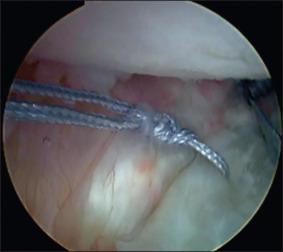
The anterior and posterior insertions of the inferior glenohumeral cardinal ligament are grasped on either side using double-loaded suture anchors at the 5:30 and 7:30 positions.
A full-thickness capsular bite is taken with each suture. We are cautious not to get overzealous with the inferior plication stitches as thicker bites increase the risk of axillary nerve injury.
The amount of plication is approximately 1 cm, but it is dependent on multiple factors, including the examination while the patient is anesthetized, hand dominance, and goal activities.
As the case proceeds superiorly, either simple or mattress sutures and a combination of suture anchor or plication stitches are utilized, depending on the quality of the glenoid labrum.
We do not routinely perform a rotator interval closure except in revision cases and in patients with known collagen disorders, and when doing so we usually only perform this closure on a patient's nondominant side.
We have not found plication stitches near the biceps anchor to be helpful and therefore we do not plicate superiorly.
Using the preoperative examination under anesthesia as the baseline, the stability exam is repeated upon completion of the plication ( Fig. 42.7 ).
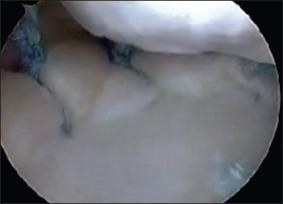
The portals are closed, dressed sterilely, and a shoulder immobilizer with abduction pillow is applied.
Become a Clinical Tree membership for Full access and enjoy Unlimited articles
If you are a member. Log in here